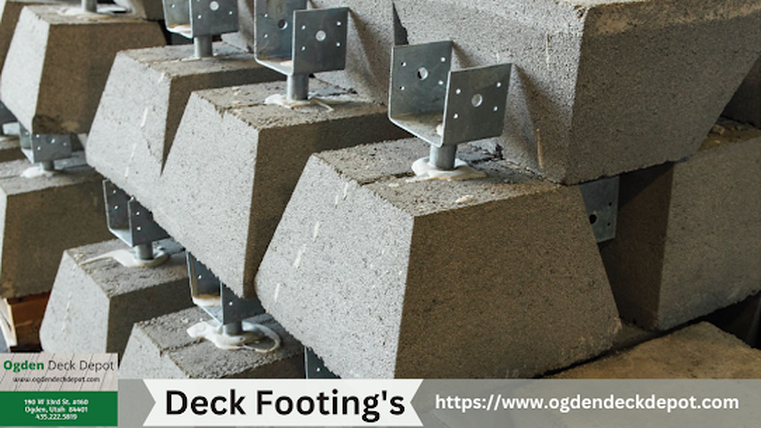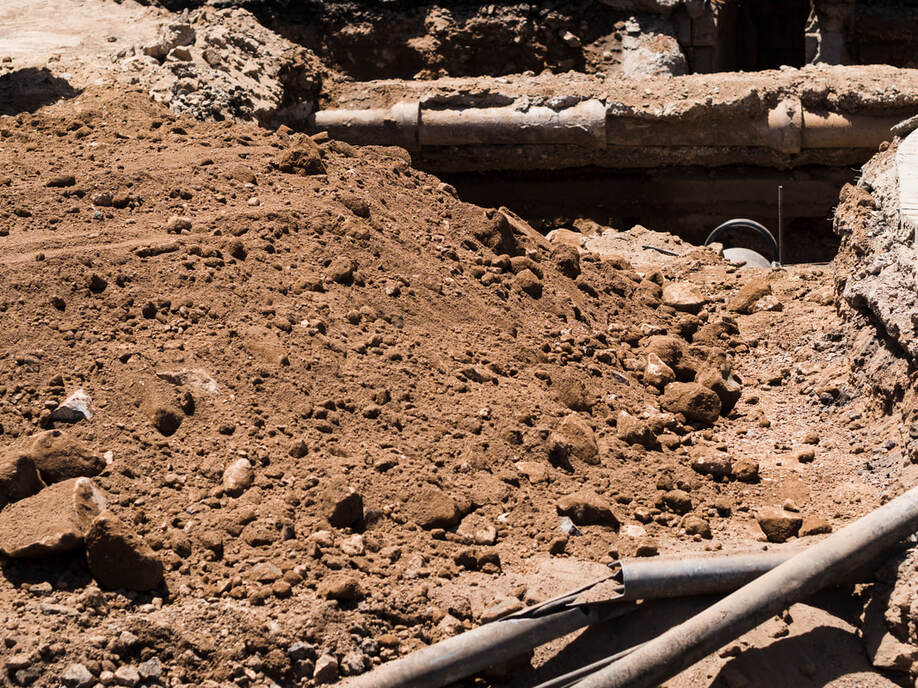Every magnificent structure, from towering skyscrapers to humble homes, owes its strength and stability to the foundation beneath it. The same holds true for your deck. In the world of outdoor living spaces, deck footing installation is essential, providing the crucial support that ensures safety, longevity, and structural integrity. In this blog, we will explore the critical role of deck footings and guide you through the essential steps to lay a strong foundation for your Ogden deck.
Definition of Deck Footings
Deck footings are concrete or structural supports that serve as the fundamental anchors for a deck's stability and safety. Their primary purpose is to distribute the weight of the deck and any loads it carries evenly to the ground, preventing settling, shifting, or collapse. By transferring these forces to the soil or bedrock below, deck footings ensure that the deck remains level, secure, and durable, allowing it to withstand environmental factors and maintain its integrity over time.
Planning Your Deck Footing Installation
Before diving into the physical installation of deck footings, careful planning is essential to ensure a sturdy and code-compliant foundation for your deck. This planning phase involves several critical steps:
- Assessing the local climate and soil conditions: Understanding the local weather patterns and soil composition is paramount. Frost heave, moisture levels, and soil stability can significantly impact the longevity of your deck.
- Obtaining necessary permits and approvals: Compliance with local building codes and regulations is non-negotiable. Secure the required permits and approvals to avoid legal complications down the road.
- Determining the deck's size, shape, and load-bearing requirements: Careful consideration of your deck's dimensions and intended use is vital. Different designs and purposes necessitate varying footing arrangements.
- Calculating the number of footings required: Precise calculations based on your deck's load-bearing requirements ensure even weight distribution and structural stability. Too few or improperly spaced footings can compromise the entire project.
Types of Deck Footings
When it comes to deck footings, there are several types to choose from. Understanding the options can help you make an informed decision based on your specific needs and circumstances. Here are some common types of deck footings:
- Concrete Piers: Concrete piers are a popular choice for deck footings. They consist of cylindrical concrete columns set into the ground, providing stable support for the deck. They are versatile, durable, and suitable for various soil types, making them a reliable option for many deck projects.
- Helical Piers: Helical piers are screw-shaped steel shafts with helical plates that are mechanically twisted into the soil. They offer excellent load-bearing capacity and are ideal for decks in areas with unstable or loose soil. Helical piers are quick to install and provide a solid foundation.
- Sonotube Footings: Sonotube footings, also known as concrete pier tubes, are cylindrical cardboard forms filled with concrete. They are easy to use and suitable for smaller deck projects or situations where minimal excavation is needed. Sonotube footings provide adequate support for lighter loads.
- Block Footings: Block footings involve placing concrete blocks on the ground to support deck posts. While they are cost-effective and easy to install, they are best suited for smaller decks or projects where frost heave is not a concern. Proper spacing and alignment are essential when using block footings.
- Slab Footings: Slab footings are solid concrete pads that rest directly on the ground's surface. They are a simple and low-cost option for deck footings, often used for smaller decks or in regions with stable soil conditions. However, they may not be suitable for larger or heavily loaded decks.
Digging and Installing Deck Footings
Digging and installing deck footings is a critical phase in the construction process. To ensure the stability and longevity of your deck, you need to follow these steps carefully. Here's an overview of each step:
Tools and Materials Required
Before you begin digging and installing deck footings, gather essential tools such as shovels, post hole diggers, measuring tape, a level, and a wheelbarrow. Materials include concrete mix, rebar (if needed), footing forms, and any necessary bracing materials depending on the type of footings you're installing. Safety equipment like gloves and eye protection is also crucial.
Marking and Digging Holes for Footings
Start by marking the locations of your footings based on your deck plan and local building codes. Then, dig holes at these marked points, ensuring they are deep enough to reach below the frost line and wide enough to accommodate the footing type you're using. Take care to dig holes to the correct depth and diameter, as this is critical for stability.
Pouring and Setting Concrete Footings
If you're using concrete footings, mix the concrete according to the manufacturer's instructions and pour it into the prepared holes. Insert any required rebar or reinforcing materials into the wet concrete, and use a level to ensure the top of the footing is even with the ground's surface. Allow the concrete to cure as per the recommended time frame, typically a few days.
Installing Helical Piers or Sonotube Footings
For helical piers, use specialized equipment to screw them into the ground until they reach the required depth. For sonotube footings, cut and place the forms in the holes, ensuring they are level and at the desired height. Then, pour concrete into the forms, following the same curing process as with standard concrete footings.
Checking For Level and Alignment
After your footings have set, it's crucial to verify that they are level and aligned correctly. Use a level to check both the individual footings and their alignment with each other, ensuring they meet your deck's load-bearing requirements. Make any necessary adjustments before proceeding with the deck construction to ensure a stable and safe structure.
Proper Spacing and Placement
Proper spacing and placement of deck footings are critical elements in ensuring the stability and longevity of your deck. Here's a detailed look at this important aspect:
Guidelines for Spacing Footings
The spacing between your deck footings depends on various factors, including the size and load-bearing capacity of your deck, local building codes, and the type of footings you're using. In most cases, footings are spaced evenly along the support beams or joists, with the distance between them falling within code requirements. This spacing helps distribute the weight of the deck evenly and prevents sagging or instability.
Proper Placement for Even Load Distribution
Correct placement of footings is essential to evenly distribute the load from the deck's structure. Ensure that each footing aligns precisely with the support beams or joists they are intended to support. If your deck includes ledger boards attached to your home, the footings near the ledger should be positioned to evenly share the weight and prevent overloading any one point.
Accounting for Ledger Boards and Posts
When planning the placement of footings, account for ledger boards (if used) and any additional posts that support the deck's structure. Ledger boards should be securely anchored to your home's structure, and footings placed beneath them should be adequately spaced to distribute the load. Additional posts, if required, should also be properly positioned to ensure even weight distribution.
Frost-Proofing and Drainage
Frost-proofing and drainage considerations are vital aspects of deck footing installation, particularly in regions with cold winters and varying moisture levels. Here's a closer look at these critical elements:
- Frost-Proof Footings: In regions with freezing winters, it's crucial to install footings that go below the frost line. This prevents the footings from being pushed upward by frost heave, which can lead to deck instability. Properly designed footings ensure the deck remains level throughout the year.
- Drainage System: Implement an effective drainage system to channel rainwater away from your deck. This prevents pooling water, which can cause wood rot and deterioration over time. Options include downspouts, gutters, and strategically placed drainage pipes or channels to direct water away from the deck structure.
- Gravel or Stone Bed: Placing a layer of gravel or crushed stone beneath your deck can improve drainage. This creates a barrier between the soil and the bottom of your deck's framing, reducing the risk of moisture-related issues and allowing water to drain more freely.
- Slope the Deck Surface: Ensure that the deck's surface has a slight slope away from the house or any structures. This encourages water runoff and prevents water from collecting on the deck, reducing the chances of mold, mildew, and structural damage.
- Waterproofing and Sealing: Consider applying a waterproofing sealant or membrane to the deck's surface and the tops of joists. This added layer of protection can prevent water from penetrating the wood, thereby extending the life of your deck and reducing maintenance requirements.
Inspections and Code Compliance
Inspections and code compliance are non-negotiable aspects of deck construction. To ensure a safe and legally compliant deck, scheduling inspections during and after installation is imperative, allowing experts to assess structural integrity at critical stages. Equally crucial is ensuring compliance with local building codes and regulations, as adhering to these standards is not just a legal requirement but a guarantee of safety. Finally, making necessary adjustments based on inspection feedback ensures that any identified issues or non-compliance are promptly addressed, resulting in a structurally sound and secure deck that stands up to scrutiny. The importance of deck footing installation, proper spacing, and compliance with regulations cannot be overstated. Building a sturdy, safe, and long-lasting deck hinges on these crucial factors. If you're embarking on a deck project, remember that our team of experts is here to assist you every step of the way. For personalized guidance and expert support, don't hesitate to contact us or visit our website today. Your dream deck is just a click or call away!
Making the Final Decision
The culmination of your research and deliberation, making the final decision for your deck supplier in Ogden is important. It involves carefully weighing all the factors and information you've gathered, trusting your instincts, and ensuring that the contract is comprehensive and fair. With a well-considered choice, you can embark on your deck project with confidence, knowing that you've selected the right partner to bring your outdoor space vision to life. Selecting the right deck supplier in Ogden involves careful consideration of various factors, from materials and customization options to reputation and customer support. By following the steps outlined in this guide, you can ensure a successful and satisfying deck project that enhances your outdoor living space. For expert guidance and top-quality deck solutions, don't hesitate to contact us or visit our website today to embark on your journey toward a beautiful and enduring deck.





